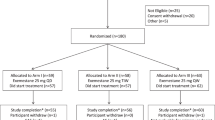Abstract
Suppression of the secretion of prolactin, growth hormone and insulin-like growth factor 1 (IGF-1) might be important in the growth regulation and treatment of breast cancer. Because oestrogens may counteract the anti-tumour effects of such treatment, the combination of an anti-oestrogen (tamoxifen), a somatostatin analogue (octreotide) and a potent anti-prolactin (CV 205-502) might be attractive. In this respect, we performed a first exploratory long-term study on the feasibility of combined treatment and possible clear differences in endocrine and anti-tumour effects during such combined treatment vs standard treatment with tamoxifen alone. Twenty-two post-menopausal patients with metastatic breast cancer (ER and/or PR positive or unknown) were randomized to receive either 40 mg of tamoxifen per day or the combination of 40 mg of tamoxifen plus 75 microg of CV 205-502 orally plus 3 x 0.2 mg of octreotide s.c. as first-line endocrine therapy. An objective response was found in 36% of the patients treated with tamoxifen alone and in 55% of the patients treated with combination therapy. Median time to progression was 33 weeks for patients treated with tamoxifen and 84 weeks for patients treated with combination therapy, but the numbers are too small for hard conclusions. There was no difference in overall post-relapse survival between the two treatment arms. With respect to the endocrine parameters, there was a significant decrease of plasma IGF-1 levels in both treatment arms, whereas during combined treatment plasma growth hormone tended to decrease and plasma prolactin levels were strongly suppressed; in some patients insulin and transforming growth factor alpha (TGF-alpha) decreased during the triple therapy. Although there was no significant difference in mean decrease of plasma IGF-1 levels between the two treatment arms, combined treatment resulted in a more uniform suppression of IGF-1. Therefore, the addition of a somatostatin analogue and an anti-prolactin may potentially enhance the efficacy of anti-oestrogens in the treatment of breast cancer owing to favourable endocrine and possible direct anti-tumour effects. Large phase III trials using depot formulations (to increase the feasibility) of somatostatin analogues are warranted to demonstrate the potential extra beneficial anti-tumour effects of such combination therapy.
This is a preview of subscription content, access via your institution
Access options
Subscribe to this journal
Receive 24 print issues and online access
$259.00 per year
only $10.79 per issue
Buy this article
- Purchase on Springer Link
- Instant access to full article PDF
Prices may be subject to local taxes which are calculated during checkout
Similar content being viewed by others
Author information
Authors and Affiliations
Rights and permissions
About this article
Cite this article
Bontenbal, M., Foekens, J., Lamberts, S. et al. Feasibility, endocrine and anti-tumour effects of a triple endocrine therapy with tamoxifen, a somatostatin analogue and an antiprolactin in post-menopausal metastatic breast cancer: a randomized study with long-term follow-up. Br J Cancer 77, 115–122 (1998). https://doi.org/10.1038/bjc.1998.18
Issue Date:
DOI: https://doi.org/10.1038/bjc.1998.18
This article is cited by
-
Somatostatin-Analoga in der Therapie des fortgeschrittenen hormonrefraktären Prostatakarzinoms
Der Urologe (2008)
-
Efficacy of the combination of long-acting release octreotide and tamoxifen in patients with advanced hepatocellular carcinoma: a randomised multicentre phase III study
British Journal of Cancer (2007)
-
Localisation of somatostatin and somatostatin receptors in benign and malignant ovarian tumours
British Journal of Cancer (2002)
-
Treatment of Metastatic Breast Cancer With Somatostatin Analogues?A Meta-Analysis
Annals of Surgical Oncology (2001)
-
Lysozyme Expression by Breast Carcinomas, Correlation With Clinicopathologic Parameters, and Prognostic Significance
Annals of Surgical Oncology (2001)



